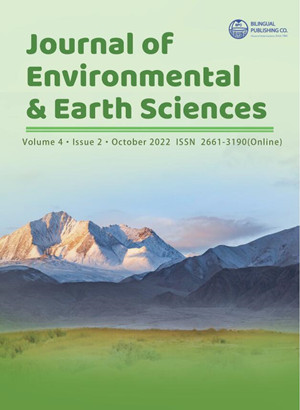
Projected Rainfall Intensity Duration Frequency Relationships under Climate Change: A Case Study of Thane City
DOI:
https://doi.org/10.30564/jees.v4i2.4995Abstract
Climate change is the most important factor to increase in short-duration high-intensity rainfall and consequent flooding. Intensity-Duration Frequency (IDF) curves are commonly used tools in Stormwater design, so a method to derive future IDF curves including climate change effects could be necessary for mainstreaming climate change information into storm water planning. The objective of the present study is to define a mechanism to reflect the effect of climate change on the projected rainfall IDF relationships. For this, the continuously observed hourly rainfall data from 1969 to 2018 were divided into five subgroups. Then the IDF curve of each subgroup is defined. The rainfall intensity for the next 30 years was then estimated using a linear regression model. The obtained result indicates that for the same duration and for the same return period, the rainfall intensity is likely to increase over time: 17% (2019-2028), 25% (2029-2038) and 32% (2039-2048). However, the findings presented in this paper will be useful for local authorities and decision makers in terms of improving stormwater design and future flood damage will be avoided.
Keywords:
Climate change; Rainfall analysis; Projected IDF relationships; IDF curves; Thane cityReferences
[1] Shahapure, S.S., Eldho, T.I., Rao, E.P., 2011. Flood simulation in an urban catchment of Navi Mumbai City with detention pond and tidal effect using FEM, GIS, and remote sensing. Journal of Waterway, Port, Costal, Ocean Engineering. 137(6), 286-299. DOI: https://doi.org/10.1061/(ASCE)0733-9429(1983)109:12(1603)
[2] Chacko, R., Kulkarni, A.T., Eldho, T.I., 2012. Urban coastal flood inundation modelling: A case study of Thane City, India. ISH Journal of Hydraulic Engineering. 18(3), 194-203. DOI: https://doi.org/10.1080/09715010.2012.721187
[3] Zope, P.E., Eldho, T.I., Jothiprakash, V., 2016. Development of rainfall intensity duration frequency curves for Mumbai City, India. Journal of Water Resource and Protection. 8, 756-765. DOI: http://dx.doi.org/10.4236/jwarp.2016.87061
[4] Dourte, D., Shukla, S., Singh, P., et al., 2013. Rainfall intensity-duration-frequency relationships for Andhra Pradesh, India: Changing rainfall patterns and implications for runoff and groundwater recharge. Journal of Hydrologic Engineering. 18(3), 324-330. DOI: https://doi.org/10.1061/(ASCE)HE.1943-5584.0000625
[5] Chawathe, S.D., Fadanvis, S.S., Goel, V.V., 1977. Rainfall analysis for the design of storm sewers in Bombay. The Institution of Engineers (India) Journal-EN. 58, 14-20.
[6] Chin, D.A., 2019. Relative performance of intensity-duration-frequency function. Journal of Hydrologic Engineering. 24(4), 04019006. DOI: https://doi.org/10.1061/(ASCE)HE.1943-5584.0001767
[7] Bell, F.C., 1969. Generalized rainfall-duration-frequency relationships. Journal of Hydraulic Division. 95, 311-327.
[8] Chen, C.L., 1983. Rainfall intensity-duration-frequency formulas. Journal of Hydraulic Engineering. 109, 1603-1621. DOI: https://doi.org/10.1061/(ASCE)0733-9429(1992)118:2(323)
[9] Babu, R., Tejwani, K.K., Agrawal, M.C., et al., 1979. Rainfall intensity-duration-return periodequations and nomographs of India, Dehradun: CSWCRTI, ICAR.
[10] Kothyari, U.C., Garde, R.J., 1992. Rainfall intensity-duration-frequency formula for India. Journal of Hydraulic Engineering. 118, 323-336. DOI: https://doi.org/10.1061/(ASCE)0733-9429(1992)118:2(323)
[11] Al-anazi, K.K., El-Sebaie, I.H., 2013. Development of intensity-duration-frequency relationships for Abha city in Saudi Arabia. International Journal of Computational Engineering Research. 3(10), 58-65.
[12] Zope, P.E., Eldho, T.I., Jothiprakash, V., 2012. Study of spatio-temporal varaitions of rainfall pattern in Mumbai City, India. Journal of Environmental Research and Development. 6(3), 545-553.
[13] Yiping, G., 2006. Updating rainfall IDF relationships to maintain urban drainage design standards. Journal of Hydrologic Engineering. 11, 506-509. DOI: https://doi.org/10.1061/(ASCE)1084-0699(2006)11:5(506)
[14] CDP, 2005. City Development Plan of Thane Municipal Corporation.
[15] Waghmare, J.S., 2017. GIS for urban air & noise pollution mapping - A Case study of Thane City, India. Population & Environment Bulletin. 13(4). Available from: https://iipsindia.ac.in/sites/default/files/project_report/Volume-13-No-4-2017.pdf
[16] Hariyali Team, 2006. Project report on repetitive water logging in Thane city: Engineering solutions and Environmental management plan. I & II.
[17] Goel, N.K., Sarkar, S., 2007. Regional rainfall intensity-duration-frequency relationship. NTPC Sponsored Training Course on Design Flood Analyses for Hydropower Projects, 2007 Aug 20-25, IIT Roorkee.
[18] Ibrahim, E.H., 2011. Developing rainfall intensity-duration-frequency relationship for two regions in Saudi Arabia. Journal of King Saud University-Engineering Science. 24, 131-140. DOI: https://doi.org/10.1016/j.jksues.2011.06.001
[19] Sreehari, E., Ghantasala, P., 2019. Climate changes prediction using simple linear regression. Journal of Computational and Theoretical Nanoscience. 16, 1-4. DOI: https://doi.org/10.1166/jctn.2019.7785
[20] Jain, S.K., Kumar, V., 2012. Trend analysis of rainfall and temperature data for India. Current Science. 102(1), 37-49.
[21] CPHEEO, 2019. Manual of Storm Water Drainage System, New Delhi: Government of India [Internet]. Available from: http://cpheeo.gov.in/cms/manual-on-storm-water-drainage-systems---2019.php
[22] Mirhosseini, G., Srivastava, P., Stefanova, L., 2013. The impact of climate change on rainfall Intensity-Duration-Frequency (IDF) curves in Alabama. Regional Environmental Change. 13, 25-33. DOI: https://doi.org/10.1007/s10113-012-0375-5
Downloads
How to Cite
Issue
Article Type
License
Copyright © 2022 Author(s)

This is an open access article under the Creative Commons Attribution-NonCommercial 4.0 International (CC BY-NC 4.0) License.







 S. S. Pujari
S. S. Pujari






